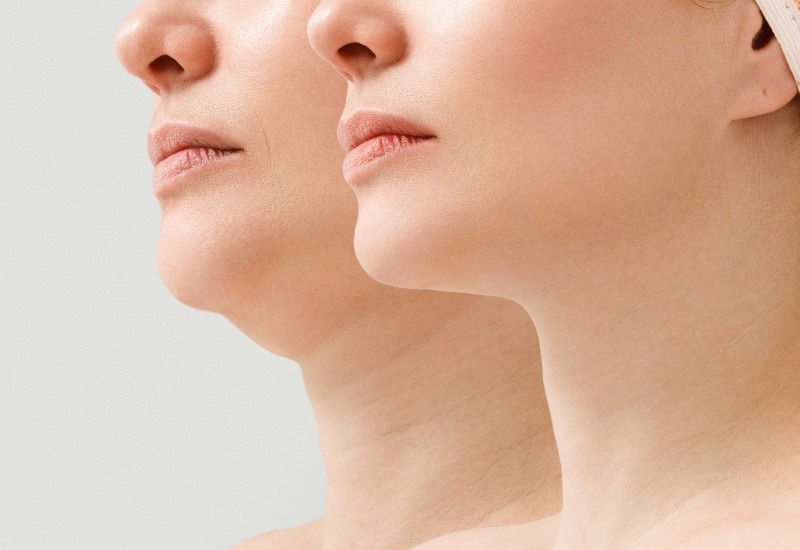A facelift, or rhytidectomy, is a cosmetic surgical procedure aimed at reducing the signs of ageing on the face and neck.
There are several types of facelift procedures, each designed to address specific concerns and achieve different outcomes.
In this article, we will discuss the different types of facelifts available so you’ll know which one might best suit your needs.

Types of Facelifts
The Mini Lift
The term “Mini Lift” typically refers to a less invasive facelift procedure designed to address early signs of ageing, particularly in the lower face and jawline.
While the specific techniques may vary among surgeons, the Mini Lift generally involves smaller incisions compared to traditional facelift procedures, resulting in a quicker recovery time.
The procedure primarily focuses on lifting and tightening the skin and underlying tissues in the lower face, including the jawline and jowls.
It is less extensive than full facelift procedures, making it suitable if you have mild to moderate signs of ageing.
Depending on the specific technique used by the surgeon, a Mini Lift may or may not involve the manipulation of deeper facial muscles (such as the SMAS – Superficial Musculoaponeurotic System).
Some variations of the Mini Lift focus more on skin tightening, while others may address a combination of skin and muscle.
Mini Lifts are often performed under local anaesthesia with sedation, reducing the risks associated with general anaesthesia. The recovery period is generally shorter compared to more extensive facelift procedures.
The SMAS Lift (Superficial Musculoaponeurotic System Lift)

The SMAS lift, or Superficial Musculoaponeurotic System lift, is a traditional facelift procedure designed to address signs of ageing in the midface, lower face and neck.
The Superficial Musculoaponeurotic System (SMAS) is a layer of tissues located beneath the skin and fat that covers the face.
This layer includes muscles, connective tissue and fat, and it plays a crucial role in facial movement and support.
The surgeon typically makes incisions along the hairline, extending around the ear and, in some cases, under the chin.
These incisions allow access to the underlying facial structures for lifting and repositioning.
The main focus of the SMAS lift is on manipulating and lifting the SMAS layer.
By doing so, the surgeon can address both the skin and the deeper tissues, providing a more comprehensive and longer-lasting improvement compared to procedures that solely address the skin.
The surgeon lifts and repositions the SMAS layer, which includes muscles and connective tissue.
This helps restore a more youthful contour to the face by addressing sagging and laxity in the midface and jowl areas.
In addition to SMAS manipulation, the surgeon may also tighten and trim excess skin to achieve a smoother and more rejuvenated appearance.
SMAS lifts are typically performed under general anaesthesia. The recovery period may involve some swelling and bruising, and patients often need to take some time off from regular activities during the initial healing phase.
This particular study suggests that the SMAS procedures provided a greater lift along both horizontal and vertical vectors than the skin lift alone.
The Extended SMAS Lift
The Extended SMAS Lift is a variation of the traditional SMAS lift, and it involves a more extensive surgical technique to address a larger area of the face.
Like the standard SMAS lift, the extended version focuses on lifting and repositioning the underlying facial muscles, tissues, and skin to achieve a more youthful and rejuvenated appearance.
The extended version also involves making incisions along the hairline, around the ear, and possibly under the chin.
These incisions allow the surgeon access to the deeper layers of facial tissues.
The primary emphasis is on manipulating and lifting the extended portion of the SMAS layer.
This extended dissection allows the surgeon to address a broader area of the face, including the midface, jowls and neck.
The surgeon lifts and repositions not only the standard SMAS layer but also extends the manipulation to cover a more extensive facial region.
This approach provides a more thorough correction of sagging and laxity in the midface and neck.
As with the traditional SMAS lift, the extended version may involve additional steps to tighten and trim excess skin, creating a smoother and more rejuvenated facial contour.
Extended SMAS lifts are typically performed under general anaesthesia.
The Composite Facelift

The Composite Facelift is a comprehensive facial rejuvenation procedure that combines elements of both the deep plane facelift and the traditional SMAS facelift.
This approach aims to address multiple layers of facial tissues, providing a more holistic and natural-looking result.
Similar to other facelift techniques, the Composite Facelift involves incisions made along the hairline, around the ear, and possibly extending into the natural creases of the skin.
These incisions allow the surgeon access to the deeper layers of facial tissues.
The term “composite” reflects the combined manipulation of both the SMAS layer and the deeper facial structures known as the deep plane.
By addressing both layers, the surgeon can lift and reposition a more extensive area of the face.
The surgeon lifts and repositions not only the SMAS but also the deeper facial structures, including muscles and connective tissues.
This dual-layer approach provides a more thorough correction of sagging and laxity in the midface, jowls, and neck.
In some cases, the Composite Facelift may involve repositioning or redistributing facial fat to restore volume in areas that have lost fullness due to ageing.
As with other facelift procedures, the Composite Facelift may include steps to tighten and trim excess skin, resulting in a smoother and more rejuvenated facial contour.
The Composite Facelift is suitable if you have significant signs of ageing in multiple facial regions, including the midface, jowls, and neck.
It is a more comprehensive solution compared to some other facelift techniques.
Liquid Facelift
A liquid facelift, often referred to as a nonsurgical facelift or injectable facelift, is a cosmetic procedure that involves the use of injectable dermal fillers and neuromodulators (such as Botox or Dysport) to achieve facial rejuvenation without surgery.
This approach is less invasive than traditional facelift surgery and is generally associated with minimal downtime.
Dermal fillers, which are often made of hyaluronic acid or other biocompatible materials, are injected into specific areas of the face to add volume, smooth wrinkles, and restore a more youthful appearance.
Common areas for filler injection include the cheeks, nasolabial folds, marionette lines, and areas with volume loss.
Neuromodulators, such as Botox or Dysport, are injected into targeted facial muscles to temporarily relax them.
This can reduce the appearance of dynamic wrinkles, particularly around the eyes and forehead. Neuromodulators are commonly used to address crow’s feet, forehead lines, and frown lines.
A liquid facelift is a customisable procedure tailored to your unique facial anatomy and aesthetic goals.
The combination of dermal fillers and neuromodulators can be adjusted to address specific concerns and achieve a natural-looking result.
Liquid facelifts are typically performed as outpatient procedures and often require minimal time.
You can often resume your normal activities shortly after the treatment.
Is it common to have other face surgeries after getting a facelift?

The decision to undergo additional face surgeries after getting a facelift depends on various factors, including individual preferences, aesthetic goals and specific areas of concern.
Some common procedures that may be considered in conjunction with or after a facelift include:
- Blepharoplasty (Eyelid Surgery) – Eyelid surgery addresses sagging skin and fat deposits around the eyes. It can be performed concurrently with a facelift or as a separate procedure to rejuvenate the upper or lower eyelids.
- Brow Lift (Forehead Lift) – A brow lift can be done to lift and tighten the brow and forehead areas. It may complement the results of a facelift by addressing sagging or heaviness in the upper face.
- Rhinoplasty (Nose Surgery) – You may choose to undergo rhinoplasty to enhance the shape and proportions of your nose. This procedure can be performed separately from a facelift.
- Chin Augmentation or Reduction – Procedures to enhance or reduce the size of the chin can improve facial balance. These surgeries may be performed independently or in combination with a facelift.
- Injectable Treatments – Non-surgical options, such as dermal fillers and neuromodulators, may be used to maintain or enhance the results of a facelift over time.
Professional Facelift Procedures That Last
As you can see there are several options available when it comes to facelift procedures.
Each facelift procedure has its unique benefits and they will be more suited to others depending on the outcome desired.
At The New Birkdale Clinic, we have a variety of facelift options available.
If you would like to speak to our specialist about getting a facelift then please contact us.
